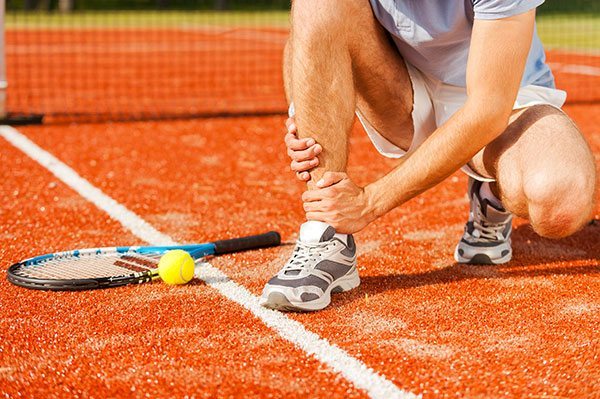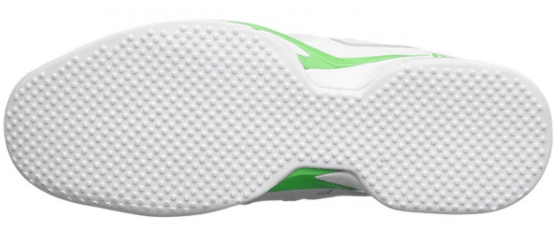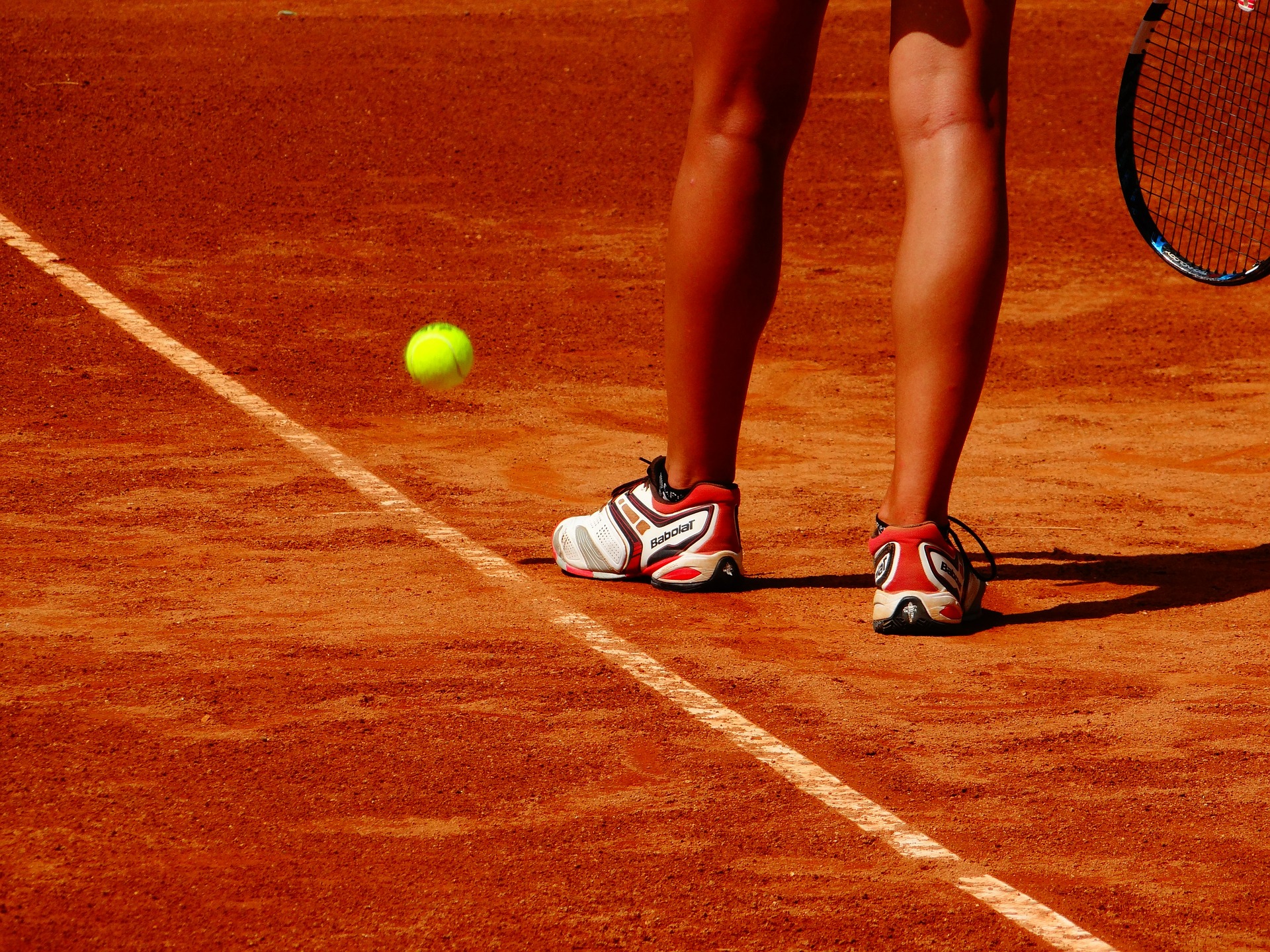Tennis Podiatry
Tennis injury?
No pain, no gain? Not in this case. The Foot and Ankle Clinic’s Tennis Podiatry will help you get more from your sport.
What is Tennis?
Tennis is a racket sport that requires speed, power, endurance, balance and coordination. It can be played individually against a single opponent or between two teams of two players each. The object of the game is to play the ball in such a way that the opponent is not able to play a valid return.
There are three main surfaces that the sport is played on. Each playing surface has unique corresponding footwear considerations that are important to preventing injury. As a result of the high speed on racquet impact, repetition and use of your spine, legs and especially your dominant arm, there can be a variety of shoulder, elbow, wrist, knee, ankle, hip and spine injuries that can develop.
Tennis Injuries
The best known tennis injury is tennis elbow. Despite its name it’s relatively uncommon in tennis players. Below are some injuries seen often in the sport:
- Lower limb injuries are the most common. They are caused by the sprinting, stopping, pivoting, jarring and pounding nature of tennis. These can be acute e.g an ankle sprain or chronic e.g. knee tendonitis.
- Upper limb injuries can occur and are usually caused by high-velocity and repetitive arm movements required in tennis. These injuries tend to be overuse in nature e.g tennis elbow
- Back injuries and pain are common due to the rotation required to hit groundstrokes, and the combination of rotation, extension and lateral flexion involved in the serve.
The ailing tennis player can benefit from a Podiatrist who is knowledgeable in the intricacies of play on multiple surfaces. Those athletes who have experienced significant fatigue due to years of play on hard courts can benefit from switching to a well-maintained clay court with the appropriate shoe.

Tennis court surfaces:
1) Hard court, a mixture of rubber acrylics, silica, asphalt or concrete and sand.
This mixture induces tremendous amounts of shock to the lower extremities with each limb supporting up to six times the player’s body weight. This produces common complaints such as:
- Patellar tendonitis
- Achilles tendonitis
- Plantar fasciitis
- Heel pain
2) Clay courts are made of crushed brick (red clay) or a proprietary mixture of natural materials with a chemical binding agent (green clay). This surface is much softer and more forgiving on the lower extremity than hard courts; however, the delicate moisture balance needed to keep clay tennis courts safe can come with its own set of challenges. Common injuries on clay courts are:
- slipping and sliding = frequent Hamstring and Achilles strains (court is too dry);
- the tennis shoe can “catch” on clumps of clay causing ankle sprains (court is too moist).
3) Grass tennis courts are uncommon surfaces for the routine tennis player. Grass is the softest surface on which tennis players play. Dry grass courts pose the same risks as clay courts. Players should avoid a moist grass court as the most common injuries on grass are:
- Ankle sprains
- Hyperextension injuries due to poor traction
4) Carpet tennis courts are uncommon for routine play given their high propensity for injury. Carpet tennis courts are sanded to allow for the softness of grass and the traction of clay. However, if the sanding is not uniform, unsanded spots will snag the plantar outsole of the shoe. Spots with too much sand can cause slippage.

Tennis Footwear:
- Hard court shoe: A rule of thumb on tennis courts is that “the harder the surface, the heavier the shoe should be”. Most hard court shoes are manufactured at around 14 to 15+ ounces for a size 10.5 shoe. This bulk gives the shoe’s outsole durability and cushioning for hours on unforgiving asphalt or concrete. Those who predominantly play on hard courts should avoid lighter, clay-specific shoes.
- Clay court shoe: Shoes with a herringbone pattern. These shoes are on the lighter end of the spectrum (10 to 13 ounces for a size 10.5 shoe). They are forgiving on wet surfaces but are also able to grip slightly dry surfaces. For patients who slide into their shots, a commonly taught technique on clay surfaces, place a layer of adhesive felt on the underside of the shoe’s vamp to prevent the forefoot from jamming in the toe box. Such a sliding motion can cause: blisters, onychodystrophy, onycholysis, subungual hematoma, turf toe and hallux limitus.
- Grass court shoe: Shoes designed for grass court play are outfitted with rubber “nubs” on the plantar and distal outsole to grip the soil underneath the grass. If the player does not have access to these shoes, a deep herringbone pattern is acceptable. The shoe should be heavy enough to grip the dirt under the blades of grass. If a patient is going to be playing on a grass court for the first time, he or she should do an extended warm up. This is to get a sense of the proprioceptive challenges that grass presents. Proprioceptive exercises for grass court tennis players or tournament participants in infrequent grass court events is important. Exercises such as drawing the alphabet with the ankle, toe curling using a towel, balance boards and single limb balancing exercises are recommended. Furthermore, many players elect for a basket weave prophylactic taping or utilise bracing prior to grass court play
- Carpet court shoe: hybrid shoe and the participant must pay close attention to the condition of the court.
Tennis Injury Risk Factors
- Different court surfaces.
- Condition of tennis balls used. (Professional players change them every seven games.)
- Type of tennis racquet.
- Tennis shot technique.
- Weather extremes.
- Inappropriate footwear.
- Poor physical conditioning.
- The amount and level of participation.
- Poor injury rehabilitation.
Common Tennis Injuries:
- Achilles Tendon Rupture
- Achilles Tendonitis/Tendinitis
- ACL Injury
- Adductor Tendinopathy
- Anterior Ankle Impingement
- Avascular Necrosis of the Femoral Head
- Back Muscle Pain
- Bicep Tendonitis
- Bulging Disc
- Bursitis Knee
- Bursitis Shoulder
- Calf Muscle Tear
- Chondromalacia Patella
- Cramps
- de Quervain’s Tenosynovitis
- Degenerative Disc Disease
- Dislocated Shoulder
- DOMS – Delayed Onset Muscle Soreness
- Facet Joint Pain
- Fat Pad Syndrome
- Femoroacetabular Impingement (FAI)
- Gluteal Tendinopathy
- Greater Trochanteric Pain Syndrome
- Groin Strain
- Hamstring Strain
- Heel Spur
- High Ankle Sprain
- Hip Arthritis (Osteoarthritis)
- Hip Labral Tear
- ITB Syndrome
- Knee Arthritis
- Knee Ligament Injuries
- Lateral Collateral Ligament
- Medial Collateral Ligament Sprain
- Meniscus Tear
- Metatarsalgia
- Morton’s Neuroma
- Muscle Strain
- Neck Arm Pain
- Neck Headache
- Neck Sprain
- Osgood Schlatter’s
- Osteitis Pubis
- Overuse Injuries
- Patella Tendonitis (Tendinopathy)
- Patellofemoral Pain Syndrome
- Peroneal Tendonitis
- Pes Anserinus Bursitis & Tendinitis
- Pes Planus – Flat Feet
- Pinched Nerve
- Piriformis Syndrome
- Plantar Fasciitis
- Plica Syndrome
- Poor Hip Core
- Posterior Ankle Impingement
- Posterolateral Corner Injury
- Retrocalcaneal Bursitis
- Rotator Cuff Calcific Tendinitis
- Rotator Cuff Syndrome
- Rotator Cuff Tear
- Sacroiliac Joint Pain
- Sciatica
- Severs Disease
- Shin Splints
- Shoulder Impingement
- Shoulder Tendonitis
- Side Strain (Abdominal)
- Sinding Larsen Johansson Syndrome
- Spondylolisthesis
- Spondylolysis (Back Stress Fracture)
- Sprained Ankle
- Stress Fracture (Feet)
- Tarsal Tunnel Syndrome
- Tennis Elbow
- Thigh Strain
- Tibialis Posterior Tendinopathy
- Trochanteric Bursitis
At the Foot and Ankle Clinic our highly qualified team of Podiatrists are all members of the Australian Podiatry Association and offer a combined 50 years’ experience. They are trained to diagnose and effectively treat tennis injuries via a range of treatments.
Put your feet in our hands! See us today in Chadstone, Moe, Sale, Traralgon, Warragul & Online Store and Retail Enquiries. NO REFERRAL NEEDED!.


